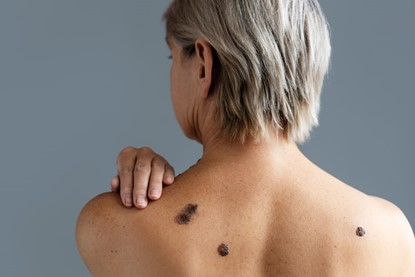The abnormal proliferation of squamous cells in the outer layer of the skin is the cause of squamous cell carcinoma (SCC).
Symptoms of Squamous Cell Carcinoma
- Rough, reddish scaly area
- Brown spot that looks like an age spot
- Wart-like growth
- Tiny, rhinoceros-shaped horn growing from your skin
- Itching
- Feeling sore or tender where you have the squamous cell skin cancer
- Numbness or a pins-and-needles sensation
Causes of Squamous Cell Carcinoma
- UV damage to skin caused by the sun or tanning beds: Indoor tanning can increase your risk of developing SCC.
- Fair skin: Greater risk of developing SCC.
- Sunburns: Blistering sunburns, are higher risk of developing squamous cell skin cancer.
- Previous skin cancer: Having had skin cancer increases your risk of developing more skin cancers.
- Age: SCC is more common in older adults, although it can occur at any age.
- Weakened immune system: Individuals who have undergone organ transplants or have HIV/AIDS, are more susceptible to developing SCC.
- Chemical exposure: Long-term exposure to chemicals, such as arsenic, can increase the risk of developing.
Treatment of Squamous Cell Carcinoma
- Surgical excision: The tumour is surgically removed along with a margin of healthy tissue.
- Mohs surgery: This specialized surgical technique removes the tumour layer by layer, minimizing damage to healthy tissue.
- Cryotherapy: The tumour is frozen with liquid nitrogen, causing it to fall off eventually.
- Radiation therapy: High-energy beams target and destroy cancer cells.
- Topical medications: Prescription creams may be applied to the affected area to treat superficial SCC.
Plastic Surgery Contributions
- Reconstructive Surgery
- Mohs Micrographic Surgery
- Scar Revision
- Functional Restoration
Prevention of Squamous Cell Carcinoma
- Plastic surgery plays a crucial role in SCC management, prevention remains the best approach.
- Practicing sun safety measures, including wearing protective clothing, applying sunscreen regularly, and avoiding tanning beds, can significantly reduce the risk of developing squamous cell carcinoma.
- Regular skin examinations and prompt evaluation of any suspicious lesions are essential for early detection and treatment.
Myths and Facts about Squamous Cell Carcinoma
Myth: Only fair-skinned individuals are at risk.
Fact: Skin type differences do not affect the development of SCC.
Myth: Indoor tanning beds are safe.
Fact: The risk of SCC rises with indoor tanning.
Myth: SCC always looks like melanoma.
Fact: SCC can have various appearances, requiring professional evaluation.
Myth: SCC won’t recur after treatment.
Fact: There is a chance of recurrence, which highlights the necessity of routine observation.
Frequently Asked Questions about Squamous Cell Carcinoma
Q: Is squamous cell carcinoma life-threatening?
A: While SCC is usually treatable if detected early, it can become more serious if left untreated, potentially leading to metastasis and complications.
Q: Can squamous cell carcinoma recur after treatment?
A: Yes, recurrence is possible, highlighting the importance of regular follow-up appointments and monitoring for any signs of new or recurrent lesions.


